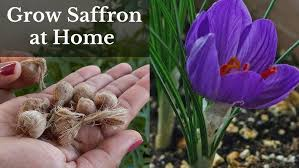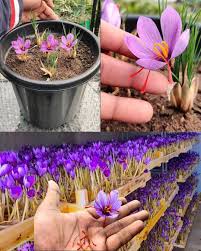Saffron, scientifically known as Crocus sativus, is one of the world’s most precious spices, cherished for its golden hue, distinct flavor, and remarkable health benefits. While often associated with sprawling fields, saffron can also be grown in containers, making it an accessible option for urban gardeners and those with limited outdoor space. With the right care and conditions, cultivating this exotic spice at home can be a rewarding and enjoyable experience.
Selecting the Perfect Container
Choosing the right container is a pivotal first step. Saffron crocuses thrive in well-draining pots that are at least 6 inches deep and 8–12 inches wide. Terracotta pots or breathable fabric planters are excellent choices as they promote proper airflow and prevent water from pooling at the roots, which can lead to rot. Be sure the containers have ample drainage holes to allow excess water to escape.
Preparing the Ideal Soil
Saffron corms (bulbs) need a loose, well-draining, nutrient-rich soil mixture to flourish. A blend of two parts potting soil to one part coarse sand or perlite works well. This combination ensures proper aeration and prevents waterlogging.
When planting, place the corms pointy side up about 4 inches deep, leaving 3 inches of space between them. Late summer to early fall is the best time to plant, allowing the corms to establish before cooler weather arrives.
Finding the Best Location
Saffron thrives in full sun, requiring at least 6–8 hours of sunlight daily. In areas with intense heat, providing some afternoon shade can protect the plants from excessive warmth. For regions with colder climates, containers can be moved indoors or to a frost-free area during winter to safeguard the corms. Saffron grows best in USDA zones 6–9 but can adapt well when provided the right conditions.
Watering and Fertilizing
Moderation is key when watering saffron. Before the corms sprout, keep the soil lightly moist but not waterlogged. Once shoots appear, water slightly more frequently, allowing the soil to dry out between waterings to avoid rot.
At the start of the growing season, enrich the soil with a balanced, slow-release fertilizer to provide the nutrients needed for healthy growth and vibrant blooms.

Harvesting Saffron
Saffron crocuses bloom for just 1–2 weeks each fall, and each flower produces three red stigmas—the precious saffron threads. Harvest the stigmas as soon as the flowers open, using tweezers for precision. Gently dry the stigmas on a paper towel in a shaded area, away from direct sunlight. Once dried, store them in an airtight container in a cool, dark place to preserve their flavor, color, and potency.
Year-Round Care
After flowering, saffron plants naturally enter a dormant phase, during which the leaves yellow and die back. During this time, reduce watering to a bare minimum. For colder climates, move containers to a sheltered area or indoors to prevent frost damage.
To ensure optimal growth in subsequent seasons, consider repotting the corms annually. Refresh the soil to replenish nutrients and avoid overcrowding, which can impede growth.
Growing saffron in containers is not only feasible but also deeply rewarding. This ancient spice, long celebrated for its culinary and medicinal qualities, can become a part of your home gardening repertoire with a little patience and care. Whether you’re looking to enhance your cooking or simply enjoy the satisfaction of growing one of the world’s rarest spices, saffron cultivation is a venture well worth undertaking.
Feel free to adapt these guidelines to suit your specific climate and gardening conditions, and enjoy the magic of growing saffron at home!
This version delivers a more structured, engaging, and informative narrative while keeping within the character limit.
